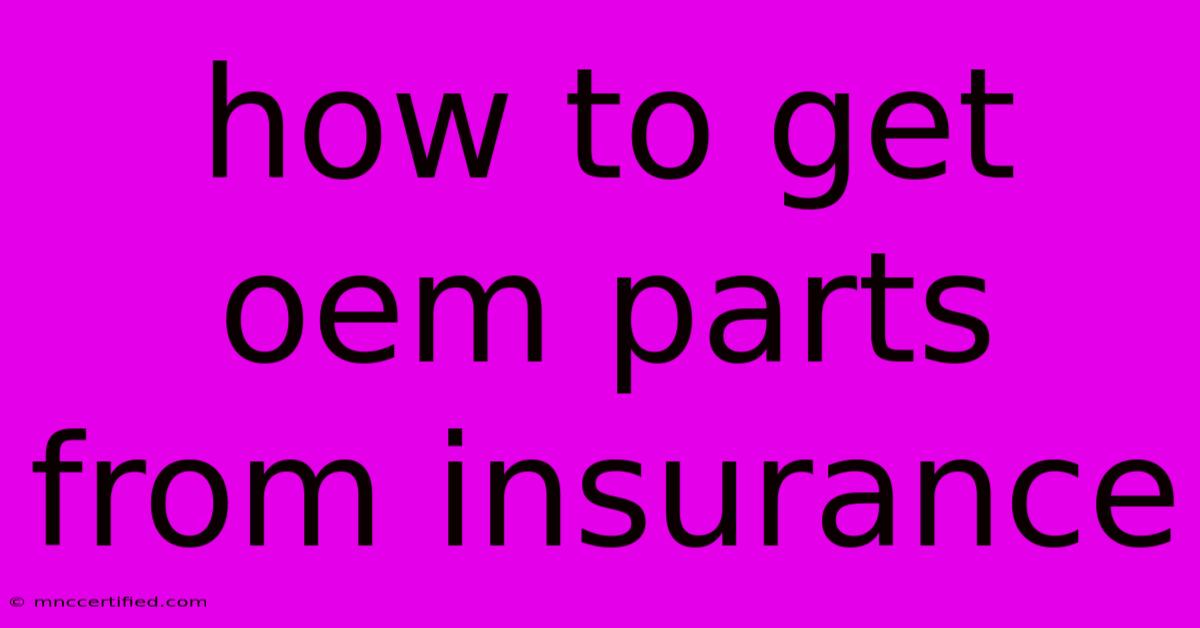How To Get Oem Parts From Insurance

Table of Contents
How to Get OEM Parts from Your Insurance for Your Car Repair
Getting into a car accident is never fun, but navigating the repair process can be even more stressful. One of the biggest decisions you'll face is choosing the type of parts used to fix your vehicle. While some insurance companies may try to push for cheaper aftermarket parts, you may prefer Original Equipment Manufacturer (OEM) parts for their quality and compatibility.
Here's how to increase your chances of getting OEM parts covered by your insurance:
1. Understand Your Policy
The first step is to familiarize yourself with your insurance policy. Look for the following details:
- Coverage: Does your policy cover collision and comprehensive damage?
- Parts Specifications: Does your policy specify using OEM parts? Some policies explicitly mention OEM parts, while others may use terms like "like kind and quality."
- Deductible: Be aware of your deductible and how it might affect your out-of-pocket expenses.
2. Communicate Clearly with Your Insurance Company
Once you understand your policy, clearly communicate your preference for OEM parts to your insurance adjuster.
- State Your Desire for OEM Parts: Clearly express your desire for OEM parts and why they are important to you. Emphasize the benefits of OEM parts, such as:
- Enhanced Safety: OEM parts are designed specifically for your vehicle, ensuring optimal safety performance.
- Improved Durability: OEM parts are built to the same rigorous standards as the original parts, offering long-term durability.
- Better Fit and Finish: OEM parts are designed to seamlessly integrate with your vehicle, avoiding potential compatibility issues.
- Explain Your Reasoning: Explain why using OEM parts is crucial to you. This could include:
- Maintaining the Value of Your Car: OEM parts help preserve your car's resale value.
- Protecting Your Investment: OEM parts ensure a quality repair that protects your investment in your vehicle.
3. Choose the Right Repair Shop
The repair shop you choose can significantly impact your chances of getting OEM parts.
- Look for Certified Repair Shops: Opt for repair shops certified by the manufacturer or reputable organizations like the Automotive Service Excellence (ASE).
- Ask About Their Parts Policy: Inquire about the repair shop's parts policy and whether they typically use OEM parts.
- Request an Estimate: Obtain a detailed estimate that outlines the parts used and their cost. This will help you understand the total repair cost and compare different repair shops.
4. Be Prepared for Negotiation
Even with a strong policy and a good repair shop, you may need to negotiate with your insurance company.
- Provide Supporting Information: Be prepared to provide supporting information about the benefits of OEM parts, such as manufacturer recommendations or independent studies.
- Be Polite but Firm: Be respectful but firm in your request for OEM parts. Don't hesitate to negotiate if the insurance company initially denies your request.
5. Explore Your Options
If your insurance company refuses to cover OEM parts, you may have other options:
- Contact Your Insurance Agent: Talk to your insurance agent to see if there are any other options available to you.
- Consider Paying Out-of-Pocket: If the price difference is significant, you may choose to pay for OEM parts out-of-pocket and then file a claim for reimbursement.
Remember: Your insurance company is required to cover the cost of repairs that restore your vehicle to its pre-accident condition. This includes using parts that meet the same quality standards as the original parts. While OEM parts may be more expensive upfront, they can offer significant long-term benefits and help you protect your investment.
By understanding your policy, communicating clearly, and being prepared to negotiate, you can increase your chances of getting OEM parts covered by your insurance.

Thank you for visiting our website wich cover about How To Get Oem Parts From Insurance. We hope the information provided has been useful to you. Feel free to contact us if you have any questions or need further assistance. See you next time and dont miss to bookmark.
Featured Posts
-
00s Rapper Announces Irish Gig Special Guest Revealed
Nov 13, 2024
-
Paul Mescals Streetcar Hits New York
Nov 13, 2024
-
Rubio Top Contender For Trump China Position
Nov 13, 2024
-
Spoelstras Call Overshadows Herros 40 Point Game
Nov 13, 2024
-
Trump Picks Noem For Homeland Security
Nov 13, 2024